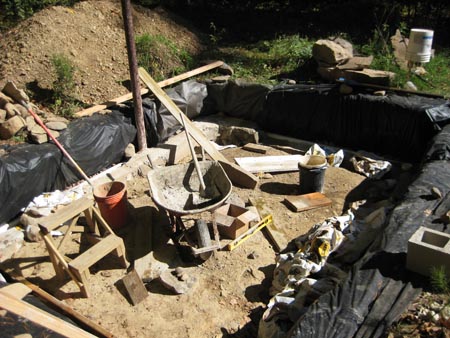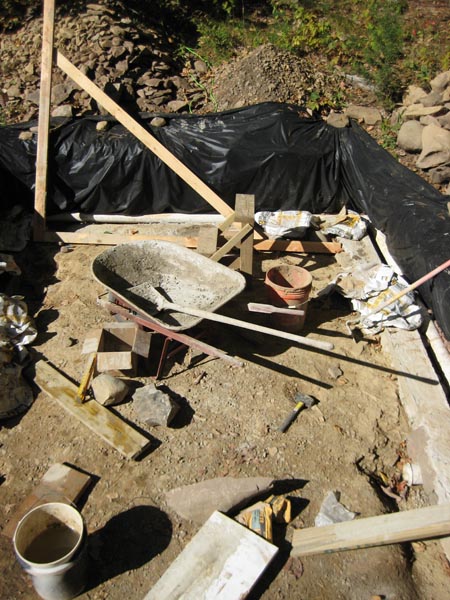|
|
|
small world dumper
Saturday, October 11 2008
Gretchen normally walks the dogs in the morning but she was in Maryland when I woke up here in Upstate New York, so it was my job to walk the dogs. I wore an MP3 player and carried a camera just in case I ran across a bear. These days the forests are rich in acorns and chipmunks, and while the former are an occasional interest of Eleanor, the latter are an interest of everyone, particularly Sally. As we walked down the lower "gullies" trail, she kept establishing new chipmunk mines. Some of these were over a foot in depth. At one point I noticed that Sally was no longer wearing her collar, so I went looking for it along the trail. After much fruitless searching, I revisited a few of her mines and finally found it buried beneath an inch of soil at the bottom of one. Sadly, I encountered no bears.
Still waiting for recently-poured concrete to harden, I didn't do much at the greenhouse site. When there's little to do, I usually find myself cleaning small pebbles and placing them around the drainage pipes, which must eventually be buried beneath clean gravel. I was tinkering at this modest task this afternoon when I found myself witness to a crime. A car (a dark sedan) driving past on Dug Hill Road pulled over to the shoulder only a hundred feet away. Evidently thinking himself safely concealed in a secluded section of forest, the driver (a dark haired white male) got out and hurled a large object into the woods. Oh no he di'n't! I shouted "Hey!" and the car sped off. I immediately regretted not sneaking up on the driver and getting his license plate number.
Curious, I walked over to where the dumping had occurred and found a cardboard box full of documents. I rooted through the box and found a tiny multifunction knife labeled "Amy" in a swirly script. I was going to simply take that and leave the box (which I'd carried up the bank) conspicuously on the shoulder, but then it occurred to me that all that paper was a free fuel for household heating. So I carried it back to the house.
The documents were slightly damp, so I laid them out on the south deck to dry. As I did so, I looked through them to see to whom they belonged. In the process I found a couple of minor valuables: a 10,000 Turkish lira note (old liras, worth slightly less than a American cent) and a two dollar bill of Canadian money (now worth slightly more than two American dollars).
The documents were all related to a series of library science courses taken back in the mid 1990s. Several of the course papers had been written by someone named Amy R***. I only know one librarian on the entire planet, and her name happens to be Amy R***. Indeed, Amy and her husband Johnny were at our wedding back in the early days of our Upstate existence, when it was thought Gretchen and I would be friends with a contingent of New Paltz people we knew through someone we'd known back in college. Those New Paltz friendships soon faded away, but it's not like I'd forgotten about those people. Amy works at the Woodstock library. I wondered if perhaps someone had stolen some boxes from her, examined their contents, and decided to chuck them into the woods, randomly chucking them into woods patrolled by someone who actually knows Amy. So I sent an email to the Woodstock library recounting what had happened.
Later I took the dogs over to Penny and David's place for a dinner comprised of risotto and delicious barbecued lake trout. Also there was Philippe, David's tall angular French friend whom I'd last seen at the Kingston Soapbox Derby. One of the topics of conversation concerned what makes Americans unique. My contribution to the conversation was that white Americans, unlike Europeans, entertain a fantasy of one day being well off and in control. This causes them to vote for policies helpful for the sort of person they aspire to be, and not so much for the sort of person they are. This theory is built on Gretchen's observations from the days when she was union organizer and found white Americans difficult to organize, no matter how miserable their position. African Americans, by contrast, are more like Europeans in that they don't have any illusions about their ability to flourish. David, who is something of a contrarian, supplied an example of an African American he knew who had somehow gone from lowly custodian to real estate mogul. But an anecdote does not a demographic trend constitute. The story also didn't reveal whether or not the gentleman in question was surprised by his meteroric financial success.

Eleanor along the Stick Trail this morning, only a couple hundred feet from home.

Eleanor along the lower (Gullies) trail.

Sally at one of her chipmunk mines. This wasn't the place where she lost her collar.

The greenhouse pit this morning, a busy hive of concrete mixing and footing construction. We're looking towards the northeast.

Another view looking west.

Overview from the spot where I've been taking a series of pictures. Looking north.

The end of the greenhouse drainage pipe (foreground) and the house (left background). The greenhouse site, sixty feet away, is in the right background. We're looking west and only about ten feet or so from the downhill neighbors' border.
For linking purposes this article's URL is:
http://asecular.com/blog.php?081011 feedback
previous | next |






